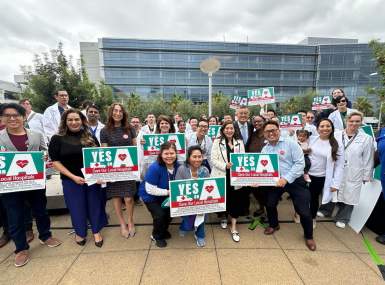Mecklenburg County enacts healthy change through church
Upcoming Events
Related News

First settled in the 1750s, when the leading cause of death in Southern Colonial America was Malaria – 1 in 4 Anglican missionaries died within five years of arrival in the Carolinas. Mecklenburg County, N.C. residents would turn to local healers and minister-physicians for a cure to their ailments.
In 2018, the residents once again looked to local faith-based organizations to tackle the current leading cause of death in the area and in the nation, cardiovascular disease (CVD). Mecklenburg County’s Village HeartBEAT (VHB) program, led by the County Health Department and supported by county government, worked to reduce the incidence of cardiovascular disease risk factors among high-risk African American populations. The program won Aetna’s Healthiest Cities and Counties Challenge grand prize and was awarded $500,000.
“It was a program that started out very small, but as the program developed, more and more citizens got involved and I can tell you that Mecklenburg County is a much healthier place because of Village HeartBEAT,” Mecklenburg County Commissioner Chairman George Dunlap said.
VHB targeted faith communities with a goal to access 24,000 church congregation members and 6,000 community residents. The project expanded the number of participating faith communities, enhanced the network of partner organizations, connected members to community-based social services, and provided training for 600 “Health Ambassadors” to create policy changes and promote healthy behaviors within congregations and local communities.
The results of the program have led to major changes in the county. Thirteen of the participating faith-based organizations adopted written indoor and outdoor tobacco-free policies, a significant step for North Carolina, where tobacco is a leading crop. Hub churches added 41 additional churches, bringing the total to 60 churches and 700 community volunteers. By using the National Behavioral Risk Factor Surveillance System (BRFSS), officials observed a reduction in smoking to 13.9 percent of parishioners from 17.4 percent.
Substituting healthier food and beverage offerings at events drove a reduction in obesity to 64.7 percent from 70 percent.
Another success is the replication of the program to other settings. Elsewhere in North Carolina, Union County has created a satellite VHB program and will participate as a new partner in future VHB strategic planning. At the national level, the Oklahoma City-County Health Department requested access to the VHB Leadership Academy curriculum - a community engagement strategy for CVD prevention and education. The international community also recognized the program through the World Council of Churches, which sponsored a 3-day workshop to explore VHB knowledge, experiences and implementation strategies for church-based health promotion. By engaging the community, the Mecklenburg County Health Department continues the long-term promotion of VHB efforts.
The American Journal of Public Health examined the partnerships available between public health agencies and faith-based organizations, pointing out that social institutions like religion are strong determinants of population health.
“That is, religious congregations and faith-based organizations are players in their communities; they present a visible, public face to their communities by providing leadership and capacity for service to others,” the article said. “These social capital assets are of special value in communities of color and of poverty and elsewhere that social and economic resources are in short supply.”
The Challenge
Successful public health initiatives share a few common ingredients: they are fundamentally rooted in principles of equity; they address a well-defined population health risk; they are approached by creative and strategic thinking; and they involve multi-sector partnerships. Even further, initiatives having a lasting impact are ones that bring together members and leaders from the community in co-designing solutions that best fit their local needs. In recent years, modern health programming has been highly committed to addressing not only the how’s of adverse health occurrences, but also examining the why’s behind these underlying characteristics. When mixed all together, the Aetna Foundation (the Foundation), in partnership with the American Public Health Association (APHA) and the National Association of Counties (NACo), sought to discover the best, replicable public health initiatives with the Healthy Cities and Counties Challenge (HCCC).
In 2016, the HCCC commissioned cities and counties of all shapes and sizes to make positive public health gains within their communities. This two-year competition distributed up to $1.5 million in prize monies among 50 city governments, local municipalities, health departments, educational institutions and other entities who leveraged the power of collaboration to unlock scalable health solutions. While the topics of the Challenge were broad - with issues ranging from health behaviors to community safety, built environment, social-economic factors, and environmental exposures - the goals were specific: participants had to promote community-wide involvement, share best practices through an ongoing learning network, and demonstrate measurable achievements to social and physical determinants of health.
Throughout the course of the competition, HCCC highlighted the role counties play in setting policies and resourcing programs that drive positive health outcomes, wellness, and public safety within their jurisdictions. During a press conference when the winners were announced, NACo president Greg Cox said, "Our winners and runners up have demonstrated the ability of counties to transform the communities they support. Organizations and leaders at the county level are in a unique position to champion the needs of local residents and join community partners in the effort to improve health outcomes for all residents to make a positive health impact."
Challenge winners and runners up were organized into two groups based on population size and were selected with assistance from an Advisory Council of public health leaders including elected officials, professors and physicians. RAND Corporation evaluated improvements in the social determinants of health and identified the most promising practices with potential for replication.
Here’s a look at the county runners-up.
Hillsborough County, Fla.’s Garden Steps Initiative
Health is being recognized as an emerging focus area for Metropolitan Planning for Transportation (MPOs). The project identified food deserts and walkability as two of the city’s biggest problems. In order to address these concerns, the project created community gardens with easy pedestrian and bicycle access in identified food deserts. The Hillsborough County MPO aims to be a model for the other 26 Florida MPOs and targets the city of Tampa, which is the largest city in Hillsborough County and is the third most populous city in Florida.
Danville, Va. (and Caswell County, N.C.)’s Danville Pittsylvania County United Fund
The Health Collaborative mobilized its action teams to study, create, and implement a youth agricultural program; address healthy eating and physical activity in and around schools and worksites; work to increase SNAP redemptions at local farmers’ markets; and adopt and implement a Complete Streets Policy for the City of Danville and walkability projects in the counties.
Waco-McLennan County, Texas’ Community Efforts to Increase Consumption of Locally Grown Fresh Foods
Waco-McLennan County helped residents in three zip codes to access and eat healthy foods in the following ways: promoting current resources of fresh and locally grown food, hosting nutrition education sessions, and utilizing community health workers to connect residents to resources and fresh produce delivery.
Chatham County, N.C.’s Leveraging Partnerships Built Through the Comprehensive Plan
Chatham County Public Health Department and Chatham Health Alliance worked on a multilevel initiative to target obesity, the leading health issue identified in the area. These two entities, along with numerous stakeholders, drafted a localized Comprehensive Plan that was unique to Chatham County residents. It included a “health in all policies” approach to encourage health behaviors in numerous aspects of life.

Attachments
Related News

CMS issues new guidance on Medicaid Community Engagement Requirements
On December 8, the Centers for Medicare & Medicaid Services (CMS) released a Medicaid and CHIP Services Informational Bulletin (CIB) directing states on how to implement the Medicaid community engagement requirements enacted under Section 71119 of the One Big Beautiful Bill Act legislation (Public Law 119-21), or H.R. 1.

California county sales tax measure backfills federal healthcare cuts
Santa Clara County, Calif. will raise an estimated $330 million each year from a sales tax to backfill lose Medicaid funding.
